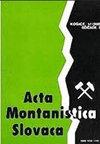由PKS、EFB和OPF的石墨结构合成生物烯氧化物
IF 1.4
4区 地球科学
Q2 GEOSCIENCES, MULTIDISCIPLINARY
引用次数: 0
摘要
由于天然石墨的提取,全球对石墨的需求不断增加,环境问题也成为改善合成石墨工艺开发的动力。然而,合成石墨生产的传统工艺需要高温、极端的工艺条件和昂贵的设备。这推动了进一步的研究工作,寻找更直接的选择。本研究以棕榈果壳(PKS)、油棕(OPF)、空果包(EFB)为碳前驱体,通过催化石墨化过程,研究了一种更简单的直接转化方法。该工艺包括原料制备、碳化工艺、铁硅催化剂浸渍和石墨化。观察到三个参数,包括石墨化温度、原料类型和铁催化剂负载量。生产的生物合成石墨后来经过“改进的方法”形成氧化石墨烯(GO)。使用X射线衍射(XRD)和拉曼光谱、Brunauer-Emmet-Teller(BET)表面积和高分辨率透射电子显微镜(HRTEM)对所制备的石墨碳进行了表征。XRD图谱和拉曼光谱证明,PKS、EFB和OPF的无定形碳完全成功地转化为石墨结构。研究发现,PKS是石墨化过程中最大的碳前驱体,其次是EFB和OPF。前者表现出与天然石墨最近的层间距,Id/Ig值最低。这可以从PKS-1300-40样品的HRTEM图像中看出。这一结果归因于PKS中木质素的百分比最高,而不是EFB和OPF中。XRD图谱和拉曼光谱也证明了生物合成石墨向GO粉末的非常显著的转变。对于生物合成石墨烯PKS,EFB和OPF描绘了具有以2为中心的宽峰的XRD图案𝜃~25°。发现在2𝜃~10.7°。本文章由计算机程序翻译,如有差异,请以英文原文为准。
The synthesis of biographene oxide from the graphitic structure of PKS, EFB and OPF
The increasing global demand for graphite and environmental issues due to the extraction of natural graphite has become motivations to improve the process development of synthetic graphite. However, the conventional process for synthetic graphite production requires high temperatures, extreme process conditions, and expensive equipment. This drives further research work on finding more straightforward options. This research study a simpler direct transformation method using Palm Kernel Shell (PKS), Oil Palm Fond (OPF, Empty Fruit Bunch (EFB) as carbon precursors via a catalytic graphitization process. The process involved raw material preparation, carbonization process, Iron-Silica catalyst impregnation and graphitization. Three parameters were observed, including graphitization temperature, type of raw material and amount of Iron catalyst loadings. The Bio-synthetic graphite produced were later undergone an “improved method” to form Graphene Oxide (GO). The graphitic carbon produced was characterized using X-Ray Diffraction (XRD) and Raman spectroscopy, Brunauer-Emmet-Teller (BET) Surface Area and High-Resolution Transmission Electron Microscope (HRTEM). Overall successful transformation of amorphous carbon to graphitic structure for PKS, EFB, and OPF was evidenced by the XRD pattern and Raman spectra. It was found that PKS was the greatest carbon precursor for the graphitization process, followed by EFB and OPF. The former exhibited the nearest interlayer spacing to natural graphite with the lowest Id/Ig value. This can be seen from the HRTEM image of the PKS-1300-40 sample. The results attributed to the highest percentage of lignin in PKS rather than in EFB and OPF. A very significant transformation of bio-synthetic graphite to GO powder was also evidenced in XRD patterns and RAMAN spectroscopy. As for bio-synthetic graphene PKS, EFB and OPF depicted XRD patterns with broad peak centring around 2𝜃~25°. It was found an absence of GO characteristic peak at 2𝜃~10.7°.
求助全文
通过发布文献求助,成功后即可免费获取论文全文。
去求助
来源期刊

Acta Montanistica Slovaca
地学-地球科学综合
CiteScore
3.60
自引率
12.50%
发文量
60
审稿时长
30 weeks
期刊介绍:
Acta Montanistica Slovaca publishes high quality articles on basic and applied research in the following fields:
geology and geological survey;
mining;
Earth resources;
underground engineering and geotechnics;
mining mechanization, mining transport, deep hole drilling;
ecotechnology and mineralurgy;
process control, automation and applied informatics in raw materials extraction, utilization and processing;
other similar fields.
Acta Montanistica Slovaca is the only scientific journal of this kind in Central, Eastern and South Eastern Europe.
The submitted manuscripts should contribute significantly to the international literature, even if the focus can be regional. Manuscripts should cite the extant and relevant international literature, should clearly state what the wider contribution is (e.g. a novel discovery, application of a new technique or methodology, application of an existing methodology to a new problem), and should discuss the importance of the work in the international context.
 求助内容:
求助内容: 应助结果提醒方式:
应助结果提醒方式:


